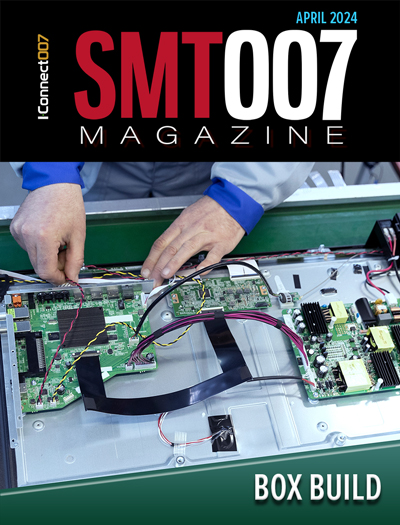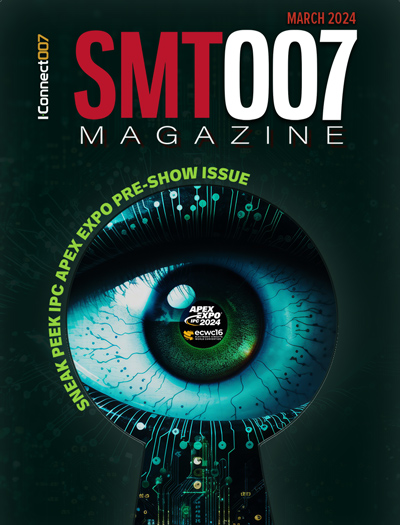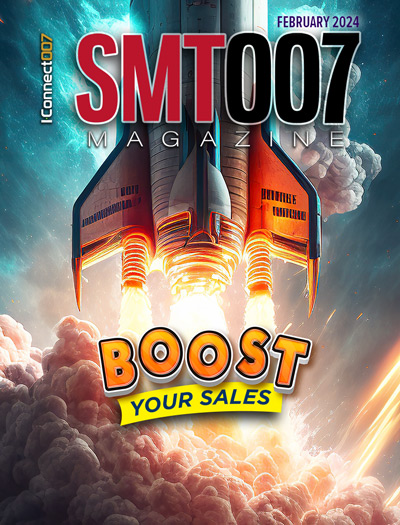-

- News
- Books
Featured Books
- smt007 Magazine
Latest Issues
Current Issue
Box Build
One trend is to add box build and final assembly to your product offering. In this issue, we explore the opportunities and risks of adding system assembly to your service portfolio.

IPC APEX EXPO 2024 Pre-show
This month’s issue devotes its pages to a comprehensive preview of the IPC APEX EXPO 2024 event. Whether your role is technical or business, if you're new-to-the-industry or seasoned veteran, you'll find value throughout this program.

Boost Your Sales
Every part of your business can be evaluated as a process, including your sales funnel. Optimizing your selling process requires a coordinated effort between marketing and sales. In this issue, industry experts in marketing and sales offer their best advice on how to boost your sales efforts.
- Articles
- Columns
Search Console
- Links
- Events
||| MENU - smt007 Magazine
Enclosed Media Printing as an Alternative to Metal Blades
June 3, 2015 | Michael L. Martel, Speed line Technologies Inc.Estimated reading time: 2 minutes
Fine pitch/fine feature solder paste printing in PCB assembly has become increasingly difficult as board geometries have become ever more compact. The printing process itself, traditionally the source of 70% of all assembly defects, finds its process window narrowing. The technology of metal blade squeegees, with the aid of new materials, understanding, and settings such as blade angle, has kept pace with all but the smallest applications.
Enclosed media print head technology has existed, and has been under increasing development, as an alternative to metal squeegee blade printing. Until recently, the performance of enclosed print heads had been comparable to the very best metal squeegees, but advances in enclosed print media technology have now made it a superior alternative to squeegee blades in virtually all applications.
Solder paste printing through stencils has long been achieved using metal blades, or squeegees, which replaced polymer squeegee blades due to performance issues years ago. The move from screens to stencils, and then to smaller apertures and fine pitch land patterns, necessitated the change to metal, which offered superior printing performance characteristics.
The evolution of PCBs in terms of the miniaturization of assemblies, components, and ever-finer feature print patterns has not slowed, and as a result continues to present ever-increasing challenges to the makers of assembly equipment and solder paste printing technology, narrowing the process window. Fine pitch and fine feature printing applications, e.g., 200μ–.50 area ratio (AR) and 150μ–.375 AR, have been pushing blade printing technology to its limits.
Skilled printer operators using superior metal blade alloys, varying angle of attack, etc., can achieve acceptable results against the most challenging printing applications, but there are shortcomings that include considerable material waste, which translates into significant cost, less fill volume as apertures become smaller, and unacceptable variation in the consistency of results. Newly developed enclosed print media technologies have been developed as an alternative to metal blade printing. Due to recent advances, enclosed media printing delivers better results overall when measured against ordinary- use metal blades, and they excel in material savings since the print head encloses the solder paste or other media from the surrounding atmosphere, providing steady and uniform results for fine feature apertures filling due to tight process control. For these and other reasons that will be outlined in this paper, they constitute an attractive alternative to metal blade printing.
Editor's Note: This article originally appeared in the May 2015 issue of SMT Magazine.
Suggested Items
AIM to Highlight NC259FPA Ultrafine No Clean Solder Paste at SMTA Wisconsin Expo & Tech Forum
04/18/2024 | AIMAIM Solder, a leading global manufacturer of solder assembly materials for the electronics industry, is pleased to announce its participation in the upcoming SMTA Wisconsin Expo & Tech Forum taking place on May 7 at the Four Points by Sheraton | Milwaukee Airport, in Milwaukee, Wisconsin.
Hentec/RPS Publishes an Essential Guide to Selective Soldering Processing Tech Paper
04/17/2024 | Hentec Industries/RPS AutomationHentec Industries/RPS Automation, a leading manufacturer of selective soldering, lead tinning and solderability test equipment, announces that it has published a technical paper describing the critical process parameters that need to be optimized to ensure optimal results and guarantee the utmost in end-product quality.
Empowering Electronics Assembly: Introducing ALPHA Innolot MXE Alloy
04/16/2024 | MacDermid Alpha Electronics SolutionsIn the rapidly evolving electronics industry, where innovation drives progress, MacDermid Alpha Electronics Solutions is committed to setting a new standard. Today, we are pleased to introduce ALPHA Innolot MXE, a revolutionary alloy meticulously engineered to address the critical needs of enhanced reliability and performance in modern electronic assemblies.
New Book on Low-temperature Soldering Now Available
04/17/2024 | I-Connect007I-Connect007 is pleased to announce that The Printed Circuit Assembler’s Guide to… Low-temperature Soldering, Vol. 2, by subject matter experts at MacDermid Alpha Electronics Solutions, is now available for download.
Inkjet Solder Mask ‘Has Arrived’
04/10/2024 | Pete Starkey, I-Connect007I was delighted to be invited to attend an interactive webinar entitled “Solder Mask Coating Made Easy with Additive Manufacturing,” hosted by SUSS MicroTec Netherlands in Eindhoven. The webinar was introduced and moderated by André Bodegom, managing director at Adeon Technologies, and the speakers were Mariana Van Dam, senior product manager PCB imaging solutions at AGFA in Belgium; Ashley Steers, sales manager at Electra Polymers in the UK; and Dr. Luca Gautero, product manager at SUSS MicroTec Netherlands.


